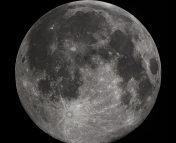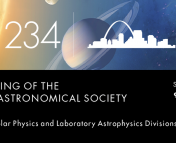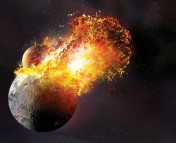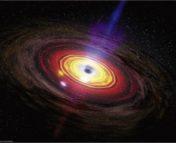Title: The origin of the Moon within a terrestrial synestia
Authors: S. J. Lock, S. T. Stewart, M. I. Petaev, et al.
First Author’s Institution: Department of Earth and Planetary Sciences, Harvard University
Status: Accepted to the Journal of Geophysical Research, open access on arXiv
It’s hard graduating and having your kick-ass group of STEM gal pals disperse across the country as we each pursue our STEM dreams. But it makes it a bit easier when our group chat goes off once in a while with messages like this:
“have yall seen this new theory of how the moon formed?? …honestly im shook”
Our Moon is quite unique. One of the most notable properties of the Earth-Moon system is that the Moon is huge compared to the Earth. In fact, the Earth and Moon have the highest planet/moon size ratio in the solar system. The Moon is about 30% of the Earth’s radius, while Titan is about 7% of Saturn’s radius, and Ganymede is about 6% of Jupiter’s. Something special had to happen for Earth to obtain such a large satellite. For a long while now, the most popular theory has been the Giant Impact Hypothesis. It is based on the idea that while the solar system and planets were forming, a body about the mass of Mars (hypothetically named Theia) collided with a proto-Earth. After the collision, the remains of Theia became the Moon. This collision theory explains why the Moon is much bigger than Earth (as well as a few other things). However, one of its weakest points is the fact that the Earth and Moon have nearly identical chemical make-ups. If the Theia was formed elsewhere in the solar system, it – and thus the Moon – would contain very different elements and molecules than the Earth.
So what other ideas do we have?
Today’s paper offers an alternative view of how the Moon came to be, and the authors are able to explain away the Giant Impact’s weakest parts. Their theory also starts with a collision, although the collider does not necessarily need to be very massive, like Theia. The collision does need to have a high energy and high angular momentum (basically the collider needs to be fast and possibly spinning/rotating at a high rate). In this paper, and supporting work, the models show that this type of impact would occur more often than a Giant Impact collision. They also show that with a high energy and high angular momentum collision with a proto-Earth, a structure called a synestia can form.

Figure 1: An artist representation of a synestia. It is a disk of debris that can theoretically form around a newly-forming planet after a collision. Today’s paper suggests that a synestia formed around the Earth and was able to form the Moon; the Earth would be located in the middle of the disky-boi and the moon is depicted as the black sphere. The moment shown in this figure occurred after the Moon had formed within the synestia, and as it was collapsing/evaporating to continue to form the Earth. This image was created by co-author Sarah Stewart/UC Davis based on NASA rendering
A synestia is a theorized structure that forms around a planet after a significant collision while the planet is still being formed. The synestia is vaporized rocky material from both the proto-Earth and the object that was the collider. The physics and chemistry of the synestia allows for these chemicals to mix, and as they mix the structure cools as radiation is emitted. The outer regions have a lower pressure than the inside of the synestia where the Earth is, so material falls to the center of the disk. The material very close to the Earth (within the Roche limit) evaporates, while material a bit farther away starts to condense into smaller bodies called moonlets (SO CUTE). Many individual moonlets form relatively quickly and independently, but in order to form our Moon they must all combine. Once a moonlet forms, it can move independently of the gas it formed in — it does however continue to interact and pick up special molecules as it roams through the synestia. It’s not really a solid rock, and is described instead as a ‘liquid moonlet’. This allows for larger moonlets to gravitationally pull in smaller moonlets and they can stick together to form an even bigger moonlet. Moonlets continue to combine until we have an object large enough to be our Moon. Throughout the process, the synestia has continued to cool and evaporate, and by the time our Moon forms, the radius of the synestia will be less than the distance from the Earth to the Moon (see Figure 1/2C). The process from start to finish is illustrated in the figure below.

Figure 2: Step-by-step proceedings of the synestia’s evaporation. We start at the top, right after a collision with the proto-Earth. The collider and Earthy materials get vaporized and form this disky structure. Moonlets form (the smaller blue dots) and interact with the gas and chemicals around them, picking up similar material as is being gained by the Earth in the center (gray). The moonlets combine to form the Moon as we know it today, and it separates from the synestia as it continues to dissipate and fall into the Earth. Figure 18 in the paper.
Move over Theia we got a new sheriff in town.(???)
This paper does a careful job of highlighting the synestia theory’s strongest points. Much of this paper dives into how the chemicals that we see on the Moon (that cannot be explained with the Giant Impact Theory) are obtained by the Moon in this special structure. The time it takes for the synestia to dissipate to within the distance of the Moon to the Earth is sufficient for enough moonlets to combine to form the Moon. And if the synestia was caused by a collision that came in at a high angle compared the the plane of the solar system, then this theory can also explain the inclination of the moon. The theory has gained a lot of momentum since publication of this paper, but it hasn’t quite yet knocked the Giant Impact theory out of popular science. There are also in-between options (check out this past astrobite) where instead of one impact, there were many smaller ones. More chemical modeling and a finer knowledge of the composition of the Moon will help us determine the best possible explanation of how our Moon came to be, because we haven’t fully figured this all out yet. But in the meantime, continue to keep your astro friends updated on the hottest new moon theories out there.




